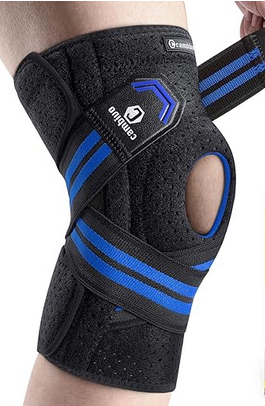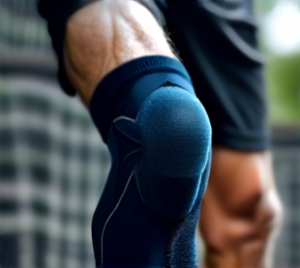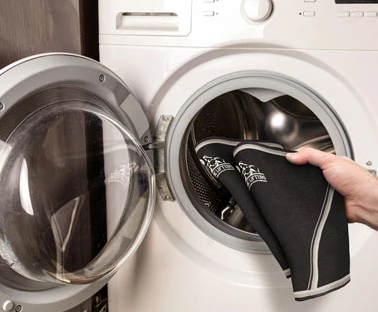
Knee compression sleeves are valuable tools for athletes and individuals dealing with knee pain or injuries. They provide support, reduce swelling, and can aid in recovery. However, a common question arises: “How long should I wear a compression sleeve on my knee?” This comprehensive guide will address this question and provide helpful advice on knee compression sleeve usage for various situations.
Understanding Knee Compression Sleeve Duration
The optimal wear time for knee support varies depending on your specific situation. Here are some general guidelines:
For Athletes and Active Individuals
- During physical activity: Wear your knee compression sleeve throughout your workout or sports activity. This provides knee support during physical activity and helps prevent injuries.
- Post-workout recovery: Keep the sleeve on for 1-2 hours after exercise to aid in recovery and reduce swelling.
- Regular workout use: For optimal support and enhanced performance, wear knee compression sleeves right before, during, and shortly after your workout. It’s important to note that you don’t need to wear them throughout the entire day for regular workout use.

For Injury Recovery and Pain Management
- Acute injuries: In the case of recent injuries, you may need to wear the compression sleeve for longer periods, up to 8-12 hours a day, as recommended by your healthcare provider.
- Chronic conditions: For ongoing knee pain management techniques, such as arthritis relief, you might wear the sleeve for several hours a day or during activities that typically cause discomfort.
- Specific conditions: When experiencing knee pain, swelling, arthritis, or runner’s knee, wearing a compression sleeve for several hours a day can significantly reduce discomfort and promote healing of the knees.
Optimal Wear Time for Knee Compression Sleeves
Discovering the optimal wear time for knee compression sleeves is crucial for maximizing their benefits while avoiding potential drawbacks. Here’s a detailed guide on when to wear them during various activities:
During Physical Activity
- Pre-activity preparation: Put on your compression sleeve about 10-15 minutes before starting your activity. This allows time for the sleeve to warm up your knee joint and increase blood flow.
- Throughout the activity: Keep the sleeve on for the entire duration of your workout or sports activity. This provides continuous support and helps maintain joint stability.
- High-intensity activities: For activities like running, basketball, or tennis, wear the sleeve throughout the entire session to maximize support and minimize the risk of injury.
- Low-impact activities: For activities like cycling or swimming, you may only need to wear the sleeve during the activity itself, as these put less stress on the knee joint.
Post-Workout Recovery
- Immediate post-activity: Keep the sleeve on for 30-60 minutes after your activity. This helps reduce immediate post-exercise swelling and supports blood flow for recovery.
- Extended recovery: For more intense workouts or if you’re prone to swelling, consider wearing the sleeve for 1-2 hours post-activity.
- Cool-down period: If possible, perform light stretches or walking with the sleeve on to aid in the cool-down process.
Daily Wear for Injury Recovery or Chronic Conditions
- Morning wear: If you experience morning stiffness, put on the sleeve shortly after waking up and wear it for 1-2 hours to help ease into daily activities.
- During problematic activities: Identify activities that typically cause discomfort (e.g., climbing stairs, prolonged standing) and wear the sleeve during these times.
- Alternating wear: For chronic conditions, consider wearing the sleeve for 3-4 hour intervals throughout the day, allowing for periods without the sleeve to prevent skin irritation and maintain natural muscle function.
Nighttime Wear
- Acute injuries: In cases of acute injuries or post-surgery, your healthcare provider might recommend wearing the sleeve overnight for additional support and to minimize swelling.
- Chronic conditions: For chronic knee issues, nighttime wear is generally not necessary unless specifically recommended by your healthcare provider.
Adjusting Wear Time
- Listen to your body: Pay attention to how your knee feels with and without the sleeve. Adjust wear time based on pain levels, swelling, and overall comfort.
- Gradual reduction: As your knee condition improves, gradually reduce the duration of wear, especially during low-stress activities.
- Consistent re-evaluation: Regularly assess the need for the compression sleeve and adjust your wear schedule accordingly, ideally in consultation with a healthcare professional.
Remember, while these guidelines provide a general framework, the optimal wear time can vary significantly between individuals based on factors such as the specific knee condition, activity level, and personal comfort. Always consult with a healthcare professional for personalized advice on how to integrate knee compression sleeves into your specific recovery or management plan.
How Many Hours a Day Should I Wear a Knee Compression Sleeve?
The duration can vary based on your specific needs and condition. Here are some general guidelines:
- For mild support: 2-4 hours per day
- For moderate support: 4-6 hours per day
- For maximum support: 6-8 hours per day
However, it’s crucial to remember that these are general recommendations. The best duration for wearing knee compression sleeves in your daily routine should be determined based on your individual circumstances. Always follow your doctor’s or physical therapist’s advice for your specific knee sleeve wearing schedule.
Monitoring Your Symptoms and Adjusting Usage
It’s essential to pay attention to how your knee responds to the compression sleeve:
- Observe changes: Keep track of any improvements or changes in pain, swelling, or stability when using the sleeve.
- Adjust as needed: If you notice increased discomfort or no improvement after several days, consider adjusting your wearing time or consult with a healthcare professional.
- Regular assessment: Periodically reassess your need for the compression sleeve, especially as your condition improves or changes.
Can You Sleep with a Compression Sleeve on Your Knee?
While it’s generally safe to sleep with a knee compression sleeve, it’s not always necessary or recommended for everyone. Here are some considerations:
- Post-surgery recovery: If you’re in the early stages of post-surgery knee compression therapy, your doctor might recommend wearing the sleeve overnight.
- Severe swelling: For significant knee swelling reduction, nighttime wear might be beneficial.
- Comfort: If the sleeve doesn’t interfere with your sleep and provides relief, it may be okay to wear it overnight.
- Skin health: Extended wear can sometimes lead to skin irritation. If you do wear it overnight, ensure proper knee sleeve application and give your skin some sleeve-free time during the day.
Always consult with your healthcare provider about the proper knee sleeve application and wearing schedule for your specific condition, especially when considering overnight use.
Long-Term Use of Compression Sleeves
While knee compression sleeves can be incredibly beneficial, it’s essential to use them correctly:
- Avoid overreliance: Don’t become overly dependent on knee supports. Gradually reduce usage as your knee strength improves.
- Balance with exercises: Combine sleeve use with knee-strengthening exercises recommended by a physical therapist.
- Monitor skin health: Check for any signs of irritation or allergic reactions, especially with long-term use of compression sleeves.
- Replace regularly: The effectiveness of compression garments can decrease over time. Replace your sleeve as recommended by the manufacturer or when it loses elasticity.
- Periodic reassessment: As your condition changes or improves, work with your healthcare provider to reassess your need for compression therapy and adjust your usage accordingly.
Special Considerations for Different Activities
- High-impact sports: For activities like running or basketball, you might benefit from wearing the sleeve throughout the entire activity and for a short period afterward.
- Low-impact activities: For activities like cycling or swimming, you might only need to wear the sleeve during the activity itself.
- Daily activities: If you have chronic knee issues, wearing the sleeve during activities that typically cause discomfort (like climbing stairs or long periods of standing) can be beneficial.
Supplemental Support for Injured Knees
While knee compression sleeves provide excellent support, they’re not the only tool available for managing knee injuries and promoting healing. Supplemental treatments and nutrients can play a crucial role in supporting knee health and recovery.
Nutritional Supplements
- Glucosamine and Chondroitin: These compounds are naturally found in cartilage and are popular supplements for joint health.
- Glucosamine helps in the formation and repair of cartilage.
- Chondroitin may help to reduce pain and inflammation, improve joint function, and slow the progression of osteoarthritis.
While research results are mixed, many people report improvements in knee pain and function when taking these supplements regularly.
- Omega-3 Fatty Acids: Found in fish oil, these have anti-inflammatory properties that may help reduce joint pain and stiffness.
- Turmeric/Curcumin: Known for its anti-inflammatory properties, turmeric may help reduce knee pain associated with arthritis.
- Collagen: This protein is a major component of cartilage. Supplementing with collagen may help improve joint health and reduce pain.
- Supplements that help with knee recovery: Read an article to learn more about supplements for knee recovery
Other Supportive Treatments
- Physical Therapy: A structured PT program can strengthen the muscles around the knee, improving stability and reducing pain.
- RICE Method: Rest, Ice, Compression (like your knee sleeve), and Elevation can help manage acute knee injuries.
- Topical Treatments: Creams or gels containing ingredients like capsaicin or menthol can provide localized pain relief.
- Acupuncture: Some people find acupuncture helpful in managing chronic knee pain.
- Braces and Orthotics: In addition to compression sleeves, other supportive devices might be recommended by your healthcare provider.
It’s important to note that while these supplements and treatments can be beneficial, they should be used in conjunction with, not as a replacement for, professional medical advice and treatment. Always consult with a healthcare provider before starting any new supplement regimen, especially if you’re taking other medications.
Furthermore, the effectiveness of these supplements can vary from person to person. What works well for one individual may not have the same effect for another. Patience is key – it may take several weeks or months of consistent use to notice significant improvements.
The Importance of Professional Guidance
While this guide provides general information on compression sleeve benefits and usage, it’s crucial to consult with a healthcare professional for personalized advice. They can provide orthopedic recommendations for compression based on your specific condition, ensuring you get the maximum benefit from your knee compression sleeve.
A healthcare professional can help you:
- Determine the right type of compression sleeve for your needs
- Establish an appropriate wearing schedule
- Adjust your usage as your condition changes
- Identify when it’s time to reduce reliance on the sleeve
Know How Long Should I Wear a Compression Sleeve on my knee? The Conclusion
The key to effective knee compression sleeve usage lies in finding the right balance for your specific needs. Whether you’re an athlete looking for knee support during physical activity or someone managing chronic knee pain, proper use of compression therapy can significantly contribute to your knee health and overall comfort.
Remember to monitor your symptoms closely and be prepared to adjust your usage based on how your knee responds. By combining proper compression sleeve use with appropriate exercise, nutritional support, and professional medical advice, you can create a comprehensive strategy for managing knee injuries and promoting long-term joint health


